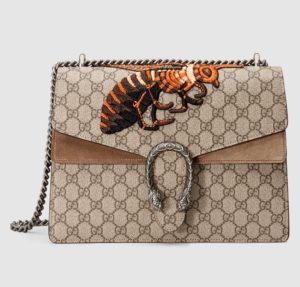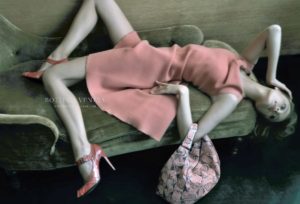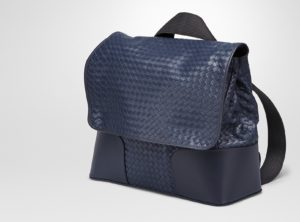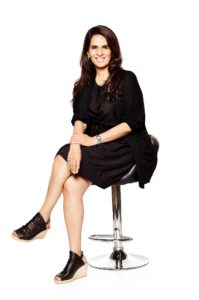
Light Dionysus GG Supreme Bag, Gucci
With luxury behemoths like Kering and Stella McCartney throwing their weight behind the sustainability trend, and President Obama urging the luxury industry to sign the Climate Pledge, sustainability is the biggest buzzword in the world of fashion.
The hottest trend in luxury fashion today can be described by the use of a single word: sustainability.
The movement towards more sustainable luxury fashion has been fuelled by US President Barack Obama’s desire to see luxury brands to join the American Business Act on Climate Pledge during his term. Among other terms, the pledge states that there should be immediately commencement of a social and economic mobilization to restore a climate that is safe, stable, and supportive of human civilization. Luxury brands that sign the American Business Act will pledge to focus on reducing industry’s carbon footprint.

Marie-Claire Daveu, Chief Sustainability Officer, Kering Photo Courtesy, Kering
“The luxury industry has a particular responsibility because it sets trends and is open to innovation,” Marie-Claire Daveu, chief sustainability officer for the Kering luxury group has said in an interview.
Kering, among the largest luxury conglomerates in the world with brands like Bottega Veneta, Brioni, Boucheron, Gucci, Stella McCartney and Ulysse Nardin, set themselves a series of 2016 sustainability targets, focusing on the group’s specific environmental and social challenges, from leather traceability and responsible gold sourcing to water pollution, chemical use and carbon emissions. “The targets we committed to in 2012 guided us to build robust and responsible approaches to address challenges within our business, and beyond, such as climate change. These approaches are now integrated into our business and I am convinced that this has built the strong foundation necessary across our Group in order to go even further in the future,” said François-Henri Pinault, Chairman and CEO of Kering recently.

Bottega Veneta
In May this year, Kering released a report which stated how climate change will negatively affect the availability and quality of key raw materials—and by extension, the vulnerable communities that are herding or farming these materials. It is also among the few luxury companies that have actually worked on the goals they set for themselves four years ago. Among the steps taken:
*An increased traceability and sourcing from EU-based production systems enabled a high quality of leather, with a lower environmental footprint.
*Sustainable alternative plastic materials were integrated into the business.
*A ban on the use of polyvinyl chloride, or PVC.
*Production by Bottega Veneta and Gucci of the “zero-deforestation” handbags
*Setting up of responsibilityinfashion.org, a trade association that provides fashion companies a three-step action plan template, industry-wide goals and listings of organizations and tools to help companies become more sustainable.
Trade associations, educational institutions, nonprofits, luxury groups and brands have followed the lead and are establishing programs aimed at making the industry more environmentally aware. In fact, there’s a talk of creating an industry-wide logo to identify clothing and accessories made in a sustainable way.

Bottega Veneta
For years, luxury brands paid mere lip service to issues like sustainability; but in the past year or two, they have become more serious about the measures taken under pressure from consumers. According to BSR, the world’s largest non-profit business network that is dedicated to the cause of a sustainable future, consumers have become aware about how their spending patterns and the way luxury is produced is affecting the environment, and have begun demanding some sort of accountability.
The stress is on improving the conditions of communities who graze and herd animals from which the brands derive their raw materials, and are affected by climate change. The Danish Fashion Institute has set up with library of sustainable fabrics—more than 1,500 cloth samples, kept in Copenhagen—and a database of 100 sustainable fabric suppliers for luxury brands to fall back on for research. In the United States, the Council of Fashion Designers of America has teamed with Lexus since 2010 for an annual eco-fashion challenge, a competition that awards cash prizes to three small, young companies committed to creating environmentally responsible fashion lines.
Most in the industry believe that radical change will come from fashion’s next generation. The Centre for Sustainable Fashion, a research center for six colleges in London works with Kering to offer “development goals” to students and entrepreneurs that focus on “authenticity, integrity and design in the face of social injustice and climate change,”
Work is also continuing on the Higg Index, that’s being set up by the Sustainable Apparel Coalition, the apparel, footwear and home textile industry association, based in San Francisco. The index, when ready in 2017, will offer a standardized supply chain measurement tool so garment tags can inform shoppers about their purchases’ social and environmental effects.

Anita Dongre
In India, in the meanwhile, Anita Dongre, among the most progressive of young fashion designers, has set up Grassroot, a sustainable luxury prêt label, rooted in the handcrafted traditions of India. “It is already becoming popular with aware young women across the globe, who love sustainable fashion,” she says. “Sustainable fashion is the future, and it is a philosophy that fashion’s future core audience, the millennials, believe in too.” Last year, when she launched Grassroot at the Lakmé Fashion Week Winter/Festive 2015, the artisans, who arrived from the airport just a few moments before the show began, walked the ramp to a standing ovation. “It literally drove the 20-something fashion bloggers in the front row to tears,” she said.
Dongre has also created an accessory line without using animal hide. “Being vegan, I was focused on finding an alternative solution. Since the entire accessory industry works with leather, it was a challenge. After years of research and trials, we have managed to create an accessory line using dhurries, thereby staying true to sustainable fashion. And sustainable fashion is certainly the future. Global ventures are now taking a stand on environment friendly products.”


